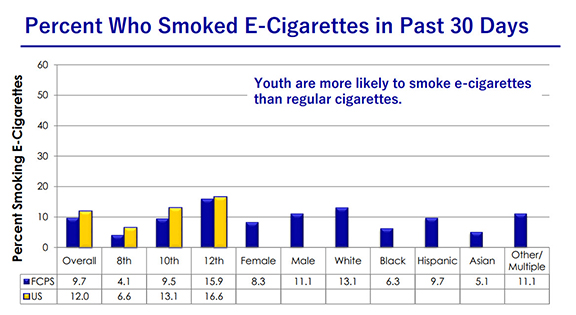
A graph demonstrates the statistics of one aspect on the survey, e-cigarettes. Photo courtesy of Fairfax County
Students take Fairfax County Youth Survey
Sophomores and seniors respond to FCPS biannual survey.
November 13, 2018
McLean High School students participated in the FCPS Youth Survey on Nov. 13 and 14 during English classes. The survey aims to gather data on the behavior of a typical FCPS student, and the levels of destructive decisions persisting throughout the county. Approximately 165 questions regarding eating disorders, mental health, drugs, alcohol, nutrition, and other behaviors of the county’s teens appeared on the questionnaire. The survey is administered to 8th, 10th and 12th grade students, with 6th grade students taking a shortened version. It was begun in 2005 and has been modified over the years.
While the survey itself was optional, all questions were voluntary to answer if the user felt uncertain or uncomfortable answering a question. All students present in class that day were invited to participate, although parents were allowed to opt students out of the survey prior to administration. The results from 2017 represent almost 36,000 students, approximately 85 percent of 8th, 10th and 12th grade students, with sixth graders’ behavior described in a separate document. While invited to participate, the report also excludes students from alternative high schools due to concerns about confidentiality.
Though the data is anonymous, each school receives an individual report in addition to county wide information.
“They give each school their individual data, but then they also show county wide data so that school administrators and county leaders can look at any trends they see or areas of need. For example, a lot of students are identifying that they struggle with anxiety or depression [and other] mental health concerns,” McLean Assistant Principal Megan Sherrill said.
The information helps give administrators a look into the typical student psyche at McLean, and it’s levels of health aspects.
“Our team can look at the data [for] McLean and say, okay, this is a significant concern here, and then we can look at the countywide data and [see if] it’s [also] a concern [throughout FCPS] or if it’s something specific to our school. We look at these trends to see the best ways we can support students here at our school,” Sherrill said.
If an issue appears to be prevalent, the McLean administration works in tandem with FCPS, utilizing resources to alleviate the situation.
“If we saw that a lot of students were engaged in high risk behaviors, then we as a school have to look at what kind of support we’re giving students so that we can help them make healthy choices,” Sherrill said.
The Fairfax County Youth Survey results indicate that when children and youth have 3 or more positive, protective factors in their lives, they are more likely to manage stress, make better choices, and develop healthy habits.
Some students were curious about how a student’s reply to the final question, inquiring their honesty on the survey, affects their results.
“[The reports] still take that data, but they do take [the honesty assertion] into consideration,” Sherrill said. She elaborated, clarifying that the results note the percentage of students reporting each level of honesty (i.e. 60% of sophomores said they were completely honest).
“There’s always going to be a margin of error and some inaccurate information. We just have to trust that the majority of kids are giving information at least somewhat based in their real experiences.”
According to the Fairfax County website, questionnaires were eliminated from the analysis if any of the following conditions were met:
• fewer than eight questions were answered
• the student answered “I was not honest at all” on the honesty question
• the student reported use of a fictitious drug (cabeniferol)
• the grade information was missing
• the student’s reported age and grade were implausible
• the student provided more than two inconsistent responses regarding substance use and other
behaviors
• the student provided pharmacologically implausible responses (i.e., a combination of drugs and
frequencies of use whose cumulative effect would be lethal)
• the student reported being in 8th grade in Pyramid 9